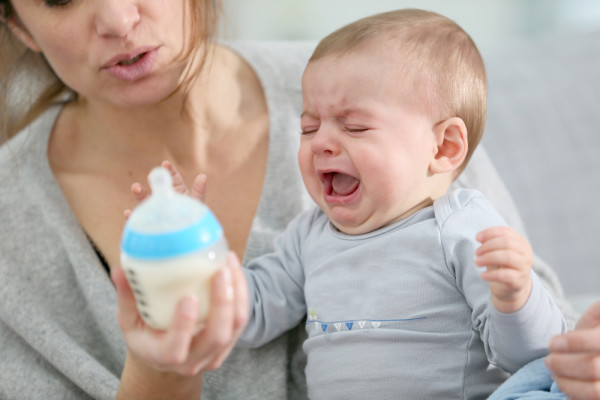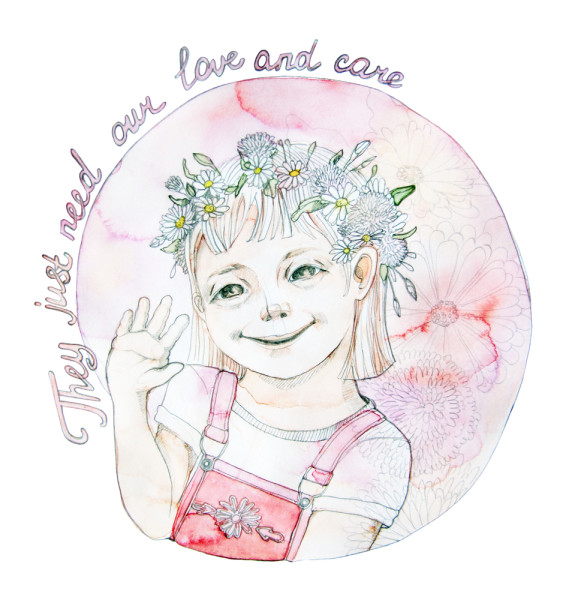The Breastfed Baby That Won’t Take a Bottle
The Breastfed Baby That Won’t Take a Bottle
By Katie Madden
Every now and then I get an email or a phone call from a mom whose breastfed baby won’t take a bottle. Perhaps she is going back to work in a few short days or perhaps she just wants a few hours to herself to go somewhere or do anything that doesn’t involve having her baby, whom she loves dearly, hanging off her boob. A baby who won’t take a bottle is a scary thing. Suddenly you are looking down the barrel of months of feeling “trapped.” You are plagued with the question:
What if my baby never takes a bottle?

Whenever I am presented with this question, I immediately spiral into PTSD. My baby never took a bottle. I can’t remember the exact details because, well, I was a crazy, exhausted, emotional, overwhelmed new mother myself.
What I do remember is buying every bottle available on the market that claimed to be “just like the breast,” including a bottle that was literally shaped like a breast. It leaked all over me. I can’t remember when I started offering, but I do know that when I went back to work when Lucy was 12-16 weeks (I can’t remember when, okay?!), she wasn’t taking a bottle. I remember my husband calling me in a panic and driving her 30 minutes to the hospital in Philly where I worked so I could come down and nurse her.
I remember my mother thickening my breastmilk with cereal (yes, cereal, people) and attempting to feed her my thickened milk with a spoon.
I remember offering her a no-spill sippy cup full of my breastmilk, but I removed the part that made it no spill. Then I helped her tip it back so she could pour it all over herself.
Do you want to know what happened in the end? I quit my job. At the time, it felt like everything in my body was telling me that my baby just wanted me to stay at home with her, so I did. In retrospect, it was not a good choice. I don’t regret it, because I don’t regret anything in my life, but I do think that this was the tipping point of a series of events that eventually led to the demise of my marriage.
And, now that I know Lucy at age eight, I know she absolutely was telling me to quit my job and I absolutely succumbed to her will. I continued to do that for the first three years of her life until at one point, in the heat of a throw-down with my terror of a three year old, I literally said to her, “YOU’RE NOT THE BOSS OF ME!” Now, most of the time, I will not be bullied by her. She is just like her mother, mind you. She will have her way if there is nobody to stand up to her (she does it to her father multiple times a day). So, I am not surprised that she bullied me when she was only a few months old.
Needless to say, I am a breastfeeding expert… not a bottle-feeding expert.
But, I have noticed something throughout the years of working with other panicky moms of non-bottle-accepting breastfed babies. There are two major components to bottle refusal:
- Reverse Nipple Confusion (baby doesn’t understand how to suck on an artificial nipple)
- Stubbornness (Baby knows damn well how to suck on a bottle and won’t because she is smart enough to know that a bottle means mama won’t be around)
My daughter suffered from a deadly combination of the two.
Component One: Avoid reverse nipple confusion altogether by starting early
Around four to six weeks, practice bottle-feeding-even if you are scared and even if you don’t want to, do it. You don’t have to replace a breastfeeding session entirely to practice this. You could just offer about one ounce, then finish up with breastfeeding. The idea here is to make sure your baby understands how to do it.
This is a really important window to teach a baby to how to suck on something other than a boob. If you miss this window, things are going to be a lot harder.
I also have this theory that babies that take a pacifier have an easier time taking a bottle. Now, I happen to be one of the only Lactation Consultants in the world who seems to think that pacifiers are fine to use as long as you aren’t using them in the first two weeks to avoid breastfeeding when the baby is clearly hungry. So, if you want to be safe, wait two to four weeks after birth to avoid the pacifier. A breastfed baby who sucks a pacifier can switch from breast sucking to artificial nipple sucking, an important skill that she must have if she is going to understand how to take a bottle.
It doesn‘t matter who offers the bottle at this stage.
A one- or two-month-old simply isn’t smart enough to know the difference. A baby three months old or older, however, is. That is when she may only accept the bottle from mom ornever accept the bottle from mom or only accept the bottle when mom is out of the house or after not eating for 4 hours or only when she is just waking up. Understand? Once they hit around three months old, they become finicky. So, start early.
Now, once you have determined that your baby can and will take a bottle, don’t make the silly mistake of thinking you can now stop practicing. Just because you baby has taken a bottle in the past, does not mean that your baby will continue to take the bottle in the future. Babies are like goldfish: very short memories.
Phase 2: Offer consistently & persistently
If you know your baby can take a bottle, great! Now be sure to offer the bottle a few times a week to make sure she doesn’t forget the skill. If you have a baby who loves her pacifier, then you can probably get away with doing this one time a week. If you have a baby who isn’t a strong pacifier sucker, do this three times a week.
Again, you do not have to replace an entire breastfeeding with a bottle if you don’t want to; you can just offer about one ounce in a bottle, then finish with the breast.
But, I do challenge you to take this bottle-feeding time as an opportunity for self-care. Do something for yourself! Go to the gym, go shopping, get your hair done, sit in the car by yourself in silence. Take a nap. Give daddy some space and time to get to know your child in a new way.
If you baby does not take a bottle, offer in place of breastfeeding consistently and persistently. That means practically everyday. That means, allow baby to get hungry enough to need the bottle. That means, don’t give in as soon as things get tough. You are up against either a confused baby or a stubborn baby-or both.
How to know whether your baby is confused or stubborn:
A confused baby mouths around the bottle nipple happily, but doesn’t suck. If milk dribbles out of the nipple, it may either pour out the side of her mouth or startle and choke her, causing her to cry and get upset. The confused baby will tolerate mouthing the lovely flavored chew toy for a few minutes before fussing to ask you to please get that thing out of her mouth.
This baby needs consistency, but a leaky bottle could be part of the problem. You would think that this baby just needs to understand that there is milk in the bottle and then she would drink, but actually, this baby needs to understand that she is supposed to suck on the bottle.
My advice for this kid:
Try a no-drip bottle that only releases milk when baby properly sucks. This will prevent her from having milk-choke when she is not ready and will reinforce good behavior by giving her a tasty treat when she does suck properly.
The Calma Nipple by Medela
The Bare Bottle by Bittylab
A stubborn baby knows how to suck a nipple. You have seen her do it. She may even regularly suck a pacifier. But, every time the bottle comes at her, she freaks out. If she is put in a situation where she is very hungry and offered a bottle, she may stubbornly drink only enough to take the edge off her hunger (further proving she can in fact drink from a bottle), but then stop and scream without finishing the rest of it.
My advice for this kid:
Consistency, persistence, and experimentation. Something is bothering her. Is it who is feeding her? Sometimes this baby will only accept a bottle from her mother because she has learned that is where food comes from. Is it from her father or another non-mother person because she has learned that she only nurses from mom, not takes a bottle? Do you have to offer it when she is very hungry? Just starting to become hungry? Upon waking from a nap? After just falling asleep? While walking in a sling? In the nursing position? In a position completely opposite from the nursing positing, such as in a bouncy chair or faced away from you? When the milk is just the same temperature as breastfeeding? When the milk is cold so it is different from breastfeeding?
Get my drift? Something will work. You just have to figure out what it is. Unfortunately, your baby can’t talk, so you are going to have to try a bunch of things.
There are a lot of “tricks” out there on the Googles as well to make your baby take a bottle. Most of these involve buying stuff or tricking your baby into thinking mom is there with a stinky shirt or something. Don’t insult your baby’s intelligence, especially if she is three months or older. I know I called the one- to two-month-old a goldfish, but once they hit three months, they are very deeply connected to their mothers. They know her by heart, by smell, and by touch. No smelly shirt is going to trick them into thinking Old Spice-smelling daddy man is life-sustaining booby woman.
A note about buying nipples: So, some people have had luck with finding the one bottle that their kid accepts, usually after spending $300 on each and every type of bottle. I have found that oftentimes this is the most frequently attempted trick and the least likely to work. The times I have seen it work is because the texture of the nipple is different, for example using a latex nipple. There aren’t many left on the market as they are all silicone now, but I have seen a bottle refuser accept a latex nipple, probably because of the color and the increased flexibility of the nipple.
If you have a confused and stubborn bottle refuser, may the force be with you. If you really need your baby to accept a bottle because you are going back to work, then be consistent and persistent. If you don’t have a strict deadline, know this:
Around six months, your baby will start eating solids and drinking water from a sippy cup, albeit poorly. By the time your baby is nine to 12 months, you will most likely be able to hold your baby off from breastfeeding for a few hours with solid foods. By 12+ months, you can offer full fat dairy foods in place of breastfeeding.
So, there is hope. At 14 months, I did go back to work. My mom primarily watched Lucy while I was gone. She ate food all evening long while I worked and may have even drunk some cow’s milk out of a cup (I don’t remember). Otherwise, it was just her and me, nursing ’round the clock. By that time, I was a single mom and Joe deeply respected our nursing relationship, so he didn’t take her from me overnight or for weekends practically until she was weaned.
Sure, it sounds like a death sentence to have a baby that never takes a bottle, but it is heartbreakingly temporary to have a baby that needs you every few hours in order to stay alive. In the blink of an eye, your little baby will be heading off to full-day kindergarten, spending the night at a friend’s house, going to sleep-away camp.
So, if you are like me and you have a strong-willed baby who refuses a bottle and just wants you to stay home and you can, know that I look back at that time of my life with so much fondness and gratitude. I don’t remember it all, but I know without a doubt I was there for every feeding. At a time when life was falling apart all around us, breastfeeding was our constant. Perhaps God knew that we would need that; what seemed at the time like our greatest challenge turned out to be our greatest gift.
Article Source: http://EzineArticles.com/?expert=Katie_Madden
http://EzineArticles.com/?The-Breastfed-Baby-That-Wont-Take-a-Bottle&id=8795306













